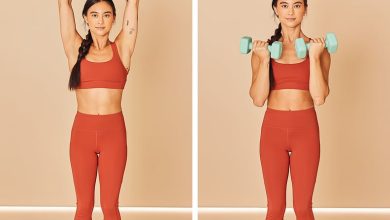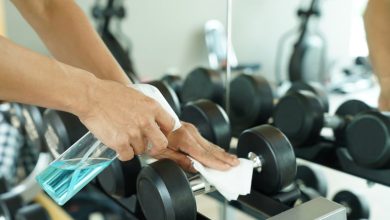What Is the 12-3-30 Workout, and Why Is Everyone (Still) Obsessed?

When I first heard about 12-3-30 — the name of the viral 30-minute treadmill incline workout taking the internet by storm — I was only mildly intrigued. TikTok has introduced us to so many exercise buzzwords throughout the years, only a few of which have actually stuck (shoutout to you, hot girl walks). Typically, my preferred cardio involves walking my dogs in the woods. But there are times when the weather doesn’t cooperate, and it would be nice to have another go-to indoor option. Enter, 12-3-30.
In essence, 12-3-30 is a simple and walkable alternative to high-intensity cardio, helping people stay motivated and consistent with their workouts. It sounds easy enough in theory, but gym-goers swear it’s actually a challenge. “It is way harder than it sounds,” says content creator Ava Vescovi in a video documenting her 12-3-30 before and after. “Trust me, you’ll be dripping sweat by the end.” Given all the hype about the 12-3-30 workout and 12-3-30 results (including transformation videos with millions of views on social media), I decided to see how well the treadmill incline workout held up IRL. Here’s what happened after trying the 12-3-30 treadmill workout for myself.
Experts Featured in This Article:
Nicole Rodriguez is a registered dietitian and NASM-certified personal trainer.
What is the 12-3-30 Workout?
12-3-30 is a 30-minute treadmill incline workout where the incline is set to 12 percent and the pace is set to three miles per hour. It’s really that simple. Influencer Lauren Giraldo first introduced the 12-3-30 workout on YouTube in 2019, but it didn’t become popular until Giraldo posted a TikTok about it in late 2020, crediting it for helping her lose weight and keep it off for years.
The workout has since gone viral, but it’s also withstood the test of time. On social media, people are still calling themselves “12-3-30 girlies” and sharing their love for the workout, including their 12-3-30 results and any modifications. From the outside looking in, 12-3-30 may seem like an unassuming cardio routine, but it’s definitely fostered a sense of community and helped cardio feel less intimidating for many.
12-3-30 Workout Benefits
12-3-30 is incredibly straightforward — no interval timers or complicated instructions required. It’s a challenging yet low-impact workout that makes cardio a little less painful, and it comes with plenty of benefits. Here are some of the most notable:
- Good For Heart Health: The 12-3-30 workout gets your heart rate up as much as a jog, without the additional impact on your joints, making it great for cardiovascular health.
- Joint-Friendly: 12-3-30 is a low-impact workout, meaning it’s easier on your joints. Additional research suggests that this kind of incline walking may even help strengthen the knee joints overtime.
- Burns Calories: The steep, 12-percent incline makes your body work harder than walking on a flat surface, explains personal trainer Nicole Rodriguez. This gets your heart rate up and places more demand on your body, forcing it to expend more energy. For example, a small 2012 study found that the metabolic cost (AKA calorie burn) of walking increased by 17 percent when set at a five-percent incline, and by 32 percent when set at a 10-percent incline (compared to walking on flat ground).
- Builds Muscle: The 12-3-30 workout also has muscle-building benefits. That same 2012 study found that incline walking increases activation in many lower body muscles. Specifically, walking on an incline strengthens your glutes, quadriceps, hamstrings, and calves more than walking on a flat surface.
12-3-30 Workout Risks
All workouts come with some level of risk, and the 12-3-30 workout is no different. “I would deem this safe with physician’s clearance,” Rodriguez says. That said, if you’re struggling with knee pain or injuries of any kind, this workout may not be right for you. To help prevent injury while incline walking, maintain good posture, engage your core, and avoid slumping forward or leaning your weight onto the handrails of the treadmill.
Additionally, the 2012 study found that adding an incline changes your walking gait. That means if you’re a beginner to steep incline workouts, you should go slowly in order to avoid injury or muscle strain. Doing too much too soon can put you at risk of an overuse injury (when tissue is damaged due to repetitive demand), according to the Hospital for Special Surgery. It’s best to gradually build up the incline and speed at your own pace.
12-3-30 Workout Results
After hearing all the hype, I decided to try the 12-3-30 workout for two weeks to see how it compared to my usual workouts (including HIIT, running, and rowing). I did the 12-3-30 method five times a week, per Giraldo’s recommendation — read on to learn about my results.
— Additional reporting by Lauren Mazzo and Chandler Plante
Before trying the 12-3-30 workout, I had been rowing 10,000 meters regularly (which takes about an hour). I didn’t want to lose my rowing endurance completely, so I cut my rowing workout in half (to about 5,000 meters). I did my rowing before 12-3-30, which helped warm up my lower back, glutes, and hamstrings for the steep 12 percent incline. After getting off the rower, I did a couple minutes of stretching before warming up on the actual treadmill.
I started with no incline at a pace of 2.0 mph for a few minutes, then I increased the incline to 12 for a few more minutes (still walking at 2.0 mph), before officially beginning the 12-3-30 workout.
Even if you’re not going to do something like rowing beforehand, it’s a good idea to do some kind of full-body warmup before hopping on the treadmill. Then spend a few minutes walking on flat ground before gradually increasing the incline to 12 percent.
When I set out to try the 12-3-30 workout, I’d already been rowing five to six times a week. Before that, I was used to running, strength training, and walking my dogs in the woods. Frankly, I thought the 12-3-30 workout would be easy. I was quickly proven wrong.
The first day, my heart rate increased more than it usually does when I’m rowing or running (as reported by my Apple Watch). Walking on an incline felt harder than running on a flat surface because I couldn’t use momentum to bounce off the balls of my feet to keep my pace. There were several moments where I had to hold on to the treadmill handles, and I even had to hop off a couple of times because my calves were getting so tired. It was humbling to get my butt kicked by a low-impact workout I assumed would be easy.
By the third day, I was able to walk without stopping, but on the fourth day, I had to stop just short of 30 minutes because my foot started to hurt. This is exactly why Rodriguez recommends talking it slow at first. I talked to my physical therapist, who told me to make sure I wasn’t heel-striking (stepping and landing on my heel instead of the ball of my foot).
I took two days off to rest and then finished the week without any foot pain. The following week, I did the 12-3-30 workout four days in a row, rested for one day, then did two more days of the workout. After my foot started to hurt again on day four, I switched to my most supportive running sneakers, took more time to warm up with actual walking, and was more mindful about how my feet landed with each step. Taking a few extra minutes to stretch my calves and feet after the workout also helped.
By the second week, the 12-3-30 workout was still feeling intense, but in a fun way. I learned that I could swing my arms harder to elevate my heart rate or hold the handles if I wanted to tone down the intensity. I also appreciated how meditative the movement was, seeing as I could leave the treadmill settings the same for the entire workout.
During 12-3-30, I also noticed that setting the pace to 3.0 mph forced me to maintain that speed. This made it so that my heart rate range was about 20 BPM (beats per minute) higher than my usual rowing, where I’m in charge of my own pace.
Content Warning: some things discussed in this slide may be triggering to those with a history of disordered eating or compulsive exercise.
Everyone’s body is different, so the number of calories you burn during the 12-3-30 workout may vary. However, when I did the 12-3-30 workout, the treadmill readout said I burned about 195 calories. I also tracked each workout over the two weeks with my Apple Watch, which said I burned between 210 and 230 total calories each time. For context, I usually burn around 205 calories during a moderate 30-minute rowing workout. Likewise, a 30-minute outdoor run burns about 240 calories, and a chill 30-minute walk around the block burns about 140 calories.
That said, it’s important to remember that the benefits of exercise go far beyond burning calories. While a lot of people come to the 12-3-30 workout for weight-loss, I’m here to confirm that the 12-3-30 workout is also a great way to feel stronger and get the endorphins flowing.
In my two weeks of trying the 12-3-30 workout, I did see some noticeable results. For starters, 12-3-30 started to instill better habits, inspiring me to use my treadmill desk more throughout the day. From a mental health standpoint, I also loved the meditative aspect of the incline walks.
On a physical level, I noticed that walking on a 12 percent incline really targeted my glutes and hamstrings. The 12-3-30 workout made me feel stronger overall, which I noticed when walking up hills, backcountry skiing, and while pulling my kids in a sled. Who knew a simple walking workout would have so many benefits?
Considering my 12-3-30 results, I’ll definitely continue to throw the workout into my weekly fitness plan to keep my muscles guessing.
Jenny Sugar is a former PS staff writer. She reports on all things fitness, but especially loves CrossFit and yoga.
Lauren Mazzo was the senior fitness editor at PS. She is a certified personal trainer and fitness nutrition specialist through the American Council on Exercise. Prior to joining PS, she worked for six years as a writer and editor for Shape Magazine covering health, fitness, nutrition, mental health, sex and relationships, beauty, and astrology.
Chandler Plante (she/her) is an assistant health and fitness editor for PS. She has over four years of professional journalism experience, previously working as an editorial assistant for People magazine and contributing to Ladygunn, Millie, and Bustle Digital Group.



